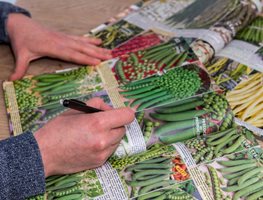10 Gardening Activities for December in the South
Here are a few garden reminders, tips, inspiring ideas, and maintenance suggestions for this month.
1. Harvest Cool-Season Crops
If you’re protecting your crops with hoop houses and row covers or you live in a mild winter climate, then those cool-season crops that you planted in late summer or early fall are most likely ready to be harvested. This would include root crops such as carrots and beets as well as greens such as kale, Swiss chard, cabbage and others. Fava beans and peas should continue producing, but they may take a break this month and in January.
2. Winterize Roses & Preorder for 2020
It’s important to stop fertilizing roses 6 to 8 weeks before your first frost. Fertilizer stimulates new growth that won’t have time to harden off. In zones with hard freezes, you also want to protect the root crown by covering it with a layer of insulation. To insulate roses, first cut back canes to roughly 1 to 2 feet. Surround the rose with a wire mesh cylinder and fill it with dry leaves, saw dust, mulch, or pine needles. You can also apply a layer of compost around the root zone of your roses. This is a good time to order roses as well. Ordering this month will ensure roses arrive at the proper time for planting (February or March). A few good resources include Proven Winners and David Austin Roses.
3. Cut Back or Stop Watering
In areas that get hard freezes, you likely winterized your irrigation system last month. If not, do so this month. In warmer zones where you don’t get hard freezes, it’s time to cut back or stop watering. If temperatures drop and you’re getting consistent rain, you can stop watering. If rain is low, cut back watering by half or hand water.
4. Winterize Containers
If freezing temperatures are expected, move containers into a shed, garage, or indoor location so they don’t crack. Alternatively, consider insulating containers with a wool blanket. In warmer areas with little frost or only short periods of freezing temperatures, you can leave containers in place. You can even update your containers with plants that enjoy cold weather such as dwarf conifers, cyclamen, gaultheria, winter green, tree heather, ivy, ornamental cabbage, and more.
5. Clean & Store Motorized Tools Properly
If you use a gasoline-powered lawn mower, edger, or other power tool, empty the gasoline from the gas tank or add a fuel stabilizer. This will prevent the fuel from breaking down and rust from forming. Run the engine for several minutes before storing the equipment. It’s also a good idea to change the oil and use a fogging oil spray to lubricate engine parts (spray lubricant into the air intake of the engine while it’s running).
Don't miss what to do in the garden each month, make sure you're getting our weekly newsletter.
6. Grow Amaryllis or Give Them as A Gift
Amaryllis ordering typically begins in September or October, but ordering in December is often still an option. Order early in the month if you want holiday blooms and select a quick-blooming variety such as Cherry Blossom or Charisma which both flower in 4 to 6 weeks. Potted amaryllis and other indoor bulb gardens also make great gifts.
7. Buy a Living Christmas Tree
Living Christmas trees are grown in containers that can be kept alive from season to season or planted in the garden rather than trees that are cut for the holiday then thrown away when it’s over. Look for a tree locally, as many garden nurseries are now stocking living trees due to their growth in popularity. There are specific varieties of trees that make good living Christmas trees: Colorado blue spruce, deodar cedar, Bruns Serbian spruce, Norway spruce, fir, as well as more offbeat varieties such as Norfolk Island pines. Look for trees that are 6 to 10 feet tall (unless you have high ceilings in which case go as big as you can fit and transport!). Leave the tree in its original container and either decorate it with felt or set it within a larger decorative container. Be sure to place your tree away from heat sources such as vents, furnaces, or fireplaces. Give trees ample water (they often need water daily).
8. Order Plant Catalogs
Sitting indoors by a warm fire with a plant catalog is one of the joys of gardening. It’s fun to dream about new plants you want to try and areas around your garden you want to improve. One of the best catalogs to get, especially in the South, comes from Plant Delights Nursery. They grow or have grown pretty much every plant in their catalog in their Juniper Level Botanic Garden located in Raleigh, North Carolina. The catalog descriptions are terrific because they are written by horticulture experts who have grown the plants in a Southern climate. Other catalogs to get include Baker Creek Heirloom Seeds, Burpee, Johnny's Selected Seeds, Logee's, Proven Winners, Seed Savers Exchange, and Territorial Seed Company.
9. Cover Compost Piles to Prevent Excessive Moisture
You don’t want your compost pile to get soggy and wet because this will slow down the decomposition and cause rot. Check your compost structure and make sure there aren’t any cracks that will allow water to leak in. If you have an open compost pile or bin, cover it with a plastic tarp to protect it from precipitation, and secure it with rope or zip ties so wind doesn’t blow it away. There are also covered bins available from companies such as Gardener’s Supply Company.
10. Prepare for Deer
During winter, deer often eat a wider variety of plants and go to greater lengths to get into gardens that have forage. Be sure to check your deer fencing for broken posts or holes. If you don’t have fencing, consider installing some if you want to keep deer out of your garden—an 8- to 9-foot fence is typically the only reliable way to keep deer out of a garden. If you just want to deter deer, consider using a deer sprinkler or an organic deer repellent. To learn more about designing a deer-resistant garden and get longer-term strategies for a fence-free garden, buy Karen Chapman’s book Deer-Resistant Design. Winter is a good time to evaluate your garden design and plan for next year.
If you enjoyed this information, sign up for our weekly newsletter. Each week, you'll get Garden Design's best delivered right to your inbox including design tips, plant picks, great gardens, outdoor living products, and events to enjoy — along with monthly gardening checklists just for your area.
Do you know someone who would enjoy this South Region gardening information? Why not share it with them?
When you purchase products through links on our site, we may receive an affiliate commission. Thank you for your support.










